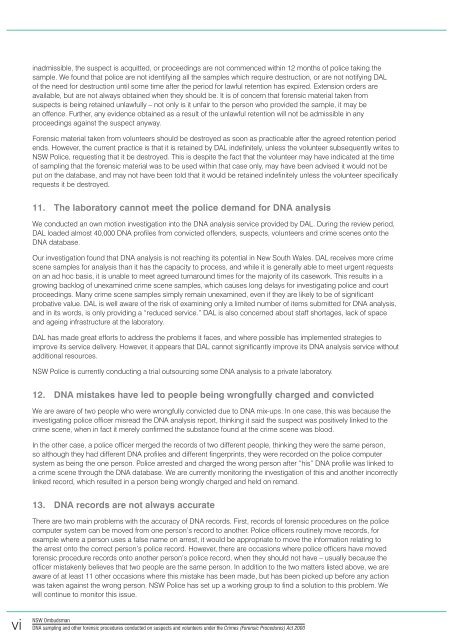Crimes (Forensic Procedures) Act 2000 - NSW Ombudsman - NSW ...
Crimes (Forensic Procedures) Act 2000 - NSW Ombudsman - NSW ...
Crimes (Forensic Procedures) Act 2000 - NSW Ombudsman - NSW ...
You also want an ePaper? Increase the reach of your titles
YUMPU automatically turns print PDFs into web optimized ePapers that Google loves.
inadmissible, the suspect is acquitted, or proceedings are not commenced within 12 months of police taking the<br />
sample. We found that police are not identifying all the samples which require destruction, or are not notifying DAL<br />
of the need for destruction until some time after the period for lawful retention has expired. Extension orders are<br />
available, but are not always obtained when they should be. It is of concern that forensic material taken from<br />
suspects is being retained unlawfully – not only is it unfair to the person who provided the sample, it may be<br />
an offence. Further, any evidence obtained as a result of the unlawful retention will not be admissible in any<br />
proceedings against the suspect anyway.<br />
<strong>Forensic</strong> material taken from volunteers should be destroyed as soon as practicable after the agreed retention period<br />
ends. However, the current practice is that it is retained by DAL indefinitely, unless the volunteer subsequently writes to<br />
<strong>NSW</strong> Police, requesting that it be destroyed. This is despite the fact that the volunteer may have indicated at the time<br />
of sampling that the forensic material was to be used within that case only, may have been advised it would not be<br />
put on the database, and may not have been told that it would be retained indefinitely unless the volunteer specifically<br />
requests it be destroyed.<br />
11. The laboratory cannot meet the police demand for DNA analysis<br />
We conducted an own motion investigation into the DNA analysis service provided by DAL. During the review period,<br />
DAL loaded almost 40,000 DNA profiles from convicted offenders, suspects, volunteers and crime scenes onto the<br />
DNA database.<br />
Our investigation found that DNA analysis is not reaching its potential in New South Wales. DAL receives more crime<br />
scene samples for analysis than it has the capacity to process, and while it is generally able to meet urgent requests<br />
on an ad hoc basis, it is unable to meet agreed turnaround times for the majority of its casework. This results in a<br />
growing backlog of unexamined crime scene samples, which causes long delays for investigating police and court<br />
proceedings. Many crime scene samples simply remain unexamined, even if they are likely to be of significant<br />
probative value. DAL is well aware of the risk of examining only a limited number of items submitted for DNA analysis,<br />
and in its words, is only providing a “reduced service.” DAL is also concerned about staff shortages, lack of space<br />
and ageing infrastructure at the laboratory.<br />
DAL has made great efforts to address the problems it faces, and where possible has implemented strategies to<br />
improve its service delivery. However, it appears that DAL cannot significantly improve its DNA analysis service without<br />
additional resources.<br />
<strong>NSW</strong> Police is currently conducting a trial outsourcing some DNA analysis to a private laboratory.<br />
12. DNA mistakes have led to people being wrongfully charged and convicted<br />
We are aware of two people who were wrongfully convicted due to DNA mix-ups. In one case, this was because the<br />
investigating police officer misread the DNA analysis report, thinking it said the suspect was positively linked to the<br />
crime scene, when in fact it merely confirmed the substance found at the crime scene was blood.<br />
In the other case, a police officer merged the records of two different people, thinking they were the same person,<br />
so although they had different DNA profiles and different fingerprints, they were recorded on the police computer<br />
system as being the one person. Police arrested and charged the wrong person after “his” DNA profile was linked to<br />
a crime scene through the DNA database. We are currently monitoring the investigation of this and another incorrectly<br />
linked record, which resulted in a person being wrongly charged and held on remand.<br />
13. DNA records are not always accurate<br />
There are two main problems with the accuracy of DNA records. First, records of forensic procedures on the police<br />
computer system can be moved from one person’s record to another. Police officers routinely move records, for<br />
example where a person uses a false name on arrest, it would be appropriate to move the information relating to<br />
the arrest onto the correct person’s police record. However, there are occasions where police officers have moved<br />
forensic procedure records onto another person’s police record, when they should not have – usually because the<br />
officer mistakenly believes that two people are the same person. In addition to the two matters listed above, we are<br />
aware of at least 11 other occasions where this mistake has been made, but has been picked up before any action<br />
was taken against the wrong person. <strong>NSW</strong> Police has set up a working group to find a solution to this problem. We<br />
will continue to monitor this issue.<br />
vi<br />
<strong>NSW</strong> <strong>Ombudsman</strong><br />
DNA sampling and other forensic procedures conducted on suspects and volunteers under the <strong>Crimes</strong> (<strong>Forensic</strong> <strong>Procedures</strong>) <strong>Act</strong> <strong>2000</strong>

















